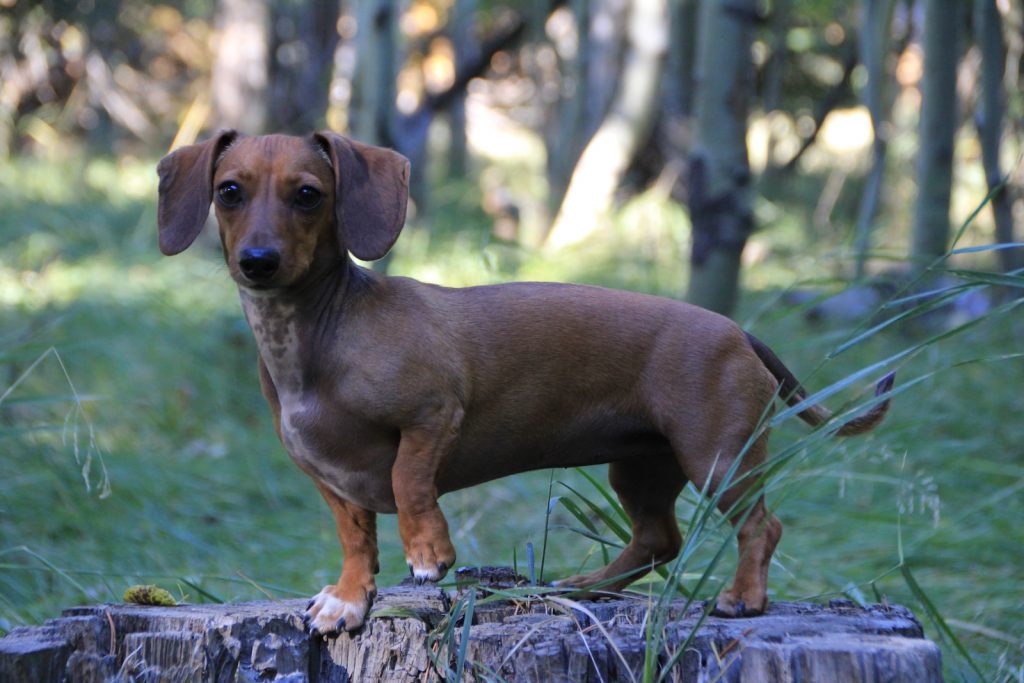Dachshund Fitness: Exercise Ideas for a Healthy Dachsie

Understanding Dachshund Exercise Needs
Dachshunds, often referred to as wiener dogs, have unique exercise needs that are important to understand in order to keep them happy and healthy. Despite their small size, these energetic pups require regular physical activity to maintain their overall well-being.
First and foremost, it’s crucial to note that dachshunds are prone to weight gain and obesity, which can lead to a variety of health issues. Therefore, it is essential to provide them with an exercise routine that helps control their weight and keeps their muscles toned. Additionally, dachshunds are highly intelligent dogs that require mental stimulation alongside physical exercise to prevent boredom and destructive behaviors. By understanding their exercise needs and incorporating both physical and mental activities into their routines, you can ensure a happy and healthy life for your dachshund companion.
Importance of Regular Exercise for Dachshunds
Regular exercise is of utmost importance for the overall health and well-being of dachshunds. These playful and energetic dogs have a tendency to put on weight easily, which can lead to a range of health issues. Engaging them in regular exercise not only helps them maintain a healthy weight, but also keeps their muscles strong and their joints flexible. In addition, exercise is essential for dachshunds to release pent-up energy, stimulating their minds and preventing boredom-induced behavioral problems.
One key benefit of regular exercise for dachshunds is the prevention of obesity. Due to their long bodies and short legs, dachshunds are prone to weight gain, which can put extra strain on their spines. This can lead to intervertebral disc disease, a serious condition that can cause pain, paralysis, and even incontinence. Engaging them in activities that promote exercise helps to burn calories and maintain a healthy weight, reducing the risk of these potentially debilitating conditions. By incorporating regular exercise into their routines, dachshunds can experience improved cardiovascular health, increased muscle tone, and enhanced overall fitness.
Indoor Exercise Ideas for Dachshunds
Dachshunds are an energetic breed that requires regular exercise to keep them happy and healthy. While outdoor activities are ideal, it’s important to have indoor exercise ideas for those days when going outside isn’t an option. One indoor exercise idea for Dachshunds is to set up a small obstacle course using household items. This can include crawling under tables, jumping over cushions, and weaving through chairs to keep them active and engaged. Another option is to play interactive games such as hide-and-seek or fetch using soft toys. These activities not only provide physical exercise but also mental stimulation, keeping your Dachshund entertained and mentally sharp even when confined indoors.
Outdoor Exercise Ideas for Dachshunds
Dachshunds are energetic and love being outdoors, so it’s important to provide them with plenty of opportunities for outdoor exercise. One great outdoor activity for dachshunds is going for walks or hikes. Take your dachshund to a nearby park or trail and let them explore the surroundings. Make sure to use a leash during walks to keep them safe and prevent them from running off.
Another outdoor exercise idea for dachshunds is playing fetch. Dachshunds have a natural instinct to chase, so throwing a ball or a toy for them to retrieve can be a fun and engaging activity. Find an open space like a backyard or a dog park where your dachshund can run freely and enjoy a game of fetch. Remember to use a soft and lightweight toy to avoid any injuries. Outdoor exercises not only provide physical exercise for dachshunds but also give them the opportunity to explore their surroundings, which is important for their mental wellbeing.
Low-Impact Exercise Options for Dachshunds
Low-impact exercise options are essential for Dachshunds, particularly for those who may have joint or mobility issues. These exercises provide a way to keep your Dachshund active and help them maintain good physical health without putting excessive strain on their bodies.
One low-impact exercise option for Dachshunds is hydrotherapy. This involves swimming in a controlled environment, such as a pool or a hydrotherapy tank. Swimming is a great low-impact exercise because it provides resistance without putting pressure on the joints. It can help strengthen muscles, improve cardiovascular health, and increase overall fitness. Additionally, hydrotherapy can be especially beneficial for Dachshunds with joint issues, as the buoyancy of the water reduces stress on the joints and allows for freer movement. However, it is important to always supervise your Dachshund during hydrotherapy sessions and ensure they feel comfortable and safe in the water.
Another low-impact exercise option for Dachshunds is walking on a treadmill. This provides a controlled and consistent workout without the potential risks associated with outdoor walks. Walking on a treadmill allows you to monitor the exercise intensity and duration, making it easier to gradually increase the challenge as your Dachshund builds strength and stamina. It is important to introduce your Dachshund to the treadmill slowly and with positive reinforcement. Always consult with a veterinarian to ensure you are using the treadmill correctly and at an appropriate pace for your Dachshund’s fitness level.
Incorporating Mental Stimulation into Dachshund Exercise Routine
Mental stimulation is just as important as physical exercise for Dachshunds. These intelligent and active dogs thrive on mental challenges, and incorporating mental stimulation into their exercise routine can keep them engaged, entertained, and mentally sharp. One way to provide mental stimulation is through interactive toys. Puzzle toys, treat-dispensing toys, and interactive games can keep your Dachshund’s mind occupied while also providing a fun and rewarding experience. These types of toys require problem-solving skills and can keep your furry friend entertained for hours. Another way to incorporate mental stimulation is through obedience training. Teaching your Dachshund new commands and tricks not only stimulates their brain but also strengthens the bond between you and your pet. It’s a win-win situation!
Tips for Exercising Dachshunds with Joint or Mobility Issues
When it comes to exercising Dachshunds with joint or mobility issues, a few key tips can help ensure their safety and well-being. First and foremost, it’s crucial to consult with your veterinarian before implementing any exercise routine. They will be able to provide specific guidance based on your Dachshund’s individual needs and condition.
One important tip is to choose low-impact exercises that put less stress on your Dachshund’s joints. Swimming can be an excellent choice, as it provides a great cardiovascular workout without putting pressure on the joints. Additionally, slow and controlled movements, such as walking or gentle stretching, can help maintain muscle strength and flexibility without exacerbating joint issues. Regular monitoring of your Dachshund’s comfort during exercise is also essential, as any signs of pain or discomfort should be taken seriously and addressed promptly. By being cautious and attentive, you can create an exercise plan that supports your Dachshund’s overall health and mobility.
Creating a Balanced Exercise Plan for Dachshunds
Creating a balanced exercise plan for Dachshunds is crucial to ensure their overall health and well-being. These little dogs have unique exercise needs, given their long bodies and short legs. It is essential to find the right balance between physical activity and rest to prevent any strain or injury.
First and foremost, it is important to incorporate both aerobic and anaerobic exercises into your Dachshund’s routine. Aerobic exercises, such as brisk walks or jogs, help to burn off excess energy and maintain a healthy weight. Anaerobic exercises, on the other hand, focus on short bursts of intense activity, which can be achieved through games like fetch or short sprints. By combining both types of exercise, you can ensure that your Dachshund gets a well-rounded workout that targets different muscle groups and keeps them engaged both physically and mentally.
Common Mistakes to Avoid When Exercising Dachshunds
One common mistake to avoid when exercising Dachshunds is overexertion. These petite dogs may have short legs, but they have plenty of energy and stamina. However, it’s important to remember that Dachshunds are prone to spinal problems, such as intervertebral disc disease. Overexertion, particularly through high-impact exercises or prolonged periods of play, can put excessive strain on their backs and increase the risk of injury. It is crucial to monitor your Dachshund’s activity levels and ensure that they get enough exercise without pushing them beyond their limits.
Another mistake to avoid is neglecting mental stimulation in your Dachshund’s exercise routine. While physical exercise is essential for their overall health, Dachshunds also have an intelligent and curious nature that craves mental stimulation. Failing to provide mental enrichment can lead to boredom and destructive behaviors. Incorporating interactive toys, puzzle games, and obedience training exercises can help keep your Dachshund mentally engaged while exercising. By challenging their minds, you can ensure a well-rounded exercise routine that meets their physical and mental needs.
Monitoring and Adjusting Your Dachshund’s Fitness Progress
To ensure the overall health and well-being of your Dachshund, it is important to closely monitor and regularly adjust their fitness progress. By keeping a close eye on your furry friend’s weight, muscle tone, and overall stamina, you can make necessary adjustments to their exercise routine to meet their changing needs.
One way to monitor your Dachshund’s fitness progress is by regularly weighing them. Keep track of their weight and compare it to their ideal weight range recommended by your veterinarian. If you notice any significant fluctuations, it may be necessary to adjust their exercise and diet accordingly. Additionally, you can observe their muscle tone and overall appearance. A healthy Dachshund should have well-developed muscles and a sleek physique. Any noticeable changes, such as excessive weight gain or loss, should be addressed promptly to avoid any potential health issues.
In terms of adjusting your Dachshund’s fitness routine, it is crucial to cater to their individual needs. Dachshunds, like any other breed, have different energy levels and exercise requirements. If you notice your Dachshund becoming less interested or fatigued during their usual exercise activities, it may be a sign that they need a change. Consider adding new elements to their routine, such as different types of exercises or mental stimulation games. Additionally, older Dachshunds may need a more gentle and low-impact approach to exercise to protect their joints and prevent injuries. Always consult with your veterinarian for guidance on how to best adjust your Dachshund’s fitness routine to ensure their health and happiness.






